1 Introduction
The cost of cathode material in lithium-ion batteries is about 40%, and the anode only accounts for about 5%. It can be seen that cathode materials play an important role in lithium-ion batteries. The cathode materials are mainly divided into three categories: layered structures, spinel structures, and olivine structures. Representative materials for spinel and olivine structures are LiMn2O4 and LiFePO4, respectively. Representative materials for layered structures are LiMO2 (M=Ni, Co, Mn) and ternary materials.
2. Brief introduction of ternary cathode material
In 1999, Zhaolin Liu [1] and others from the National University of Singapore proposed for the first time a three-component layered Li(Ni,Co,Mn)O2 material with different compositions. The synergistic effect of Ni-Co-Mn combined with the cyclic performance of LiCoO2. Well, the high specific capacity of LiNiO2 and the low cost of LiMnO2 provide good safety performance.
A general understanding of the performance of ternary cathode materials can be obtained from Figure 1.
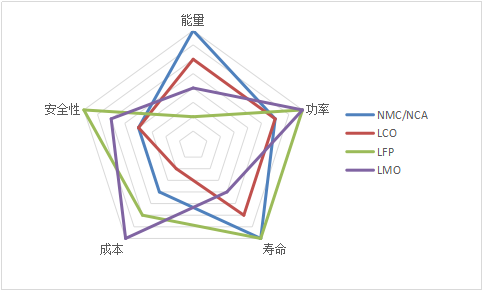
Figure 1 Comparison of performance of several cathode materials
For electric cars, to run further, they must have higher battery power. Compared to LFP, which is widely used in power batteries, ternary materials have higher energy and are more effective in improving endurance. Promising. At present, the price of electric vehicles in the industry is very high, and the high cost of power batteries is one of the important reasons. Its price accounts for almost half of the entire vehicle.
The ternary positive electrode material has a longer life, so that the power battery can be used for a longer time, thereby improving the cost performance of the electric vehicle. However, in January last year, the state suspended the use of three-cell lithium-ion batteries in passenger cars, mainly due to the unstable performance of ternary materials. After all, in the explosion of knowledge today, nothing can stop people from exploring new technologies, in addition to security issues.
With the change of the ratio of Ni-Co-Mn three elements, the ternary materials are roughly divided into two types, Ni:Mn equivalent and nickel-rich. In the former, Co is +3, Ni is +2, and Mn is +4. Since Mn has a stable structure, Ni loses two electrons during charging and maintains high capacity characteristics of the material.
In order to increase the capacity of the battery and increase the content of Ni, it is called a nickel-rich type. In this type of material, Co is +3, Ni is +2/+3, and Mn is +4. When the charging voltage is lower than 4.4V (vs. Li+/Li), Ni+2/+3 is oxidized to form Ni+4; continuing charging, Co3+ participates in the reaction to generate Co4+ at a higher voltage. When charging and discharging below 4.4V, the higher the content of Ni, the greater the reversible specific capacity of the material.
The NCA formed by replacing Mn4+ with Al3+ is also a high-Ni ternary material. Al3+ and Mn4+ have the same valence as the stable structure. The Co content affects the ionic conductivity of the material, and the higher the content, the better the charge-discharge rate. Figure 2 compares the performance of the ternary materials for the different components.
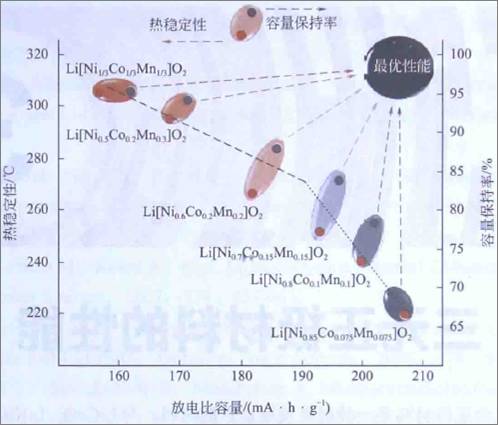
Fig. 2 Relationship between discharge specific capacity, thermal stability, and capacity retention of ternary materials with different compositions
As can be seen from the figure, as the Ni content increases, the specific spot-loading capacity increases from 160 mA·h·g-1 to more than 200 mA·h·g-1, while the thermal stability and the capacity retention rate decrease.
3. Problems with ternary materials
Influence of increasing Ni content
By increasing the Ni content in the ternary material, the battery capacity can be increased. However, cycle performance and thermal stability have deteriorated. When the Ni content increases, phase transitions occur during the redox process, resulting in a decrease in capacity. The increase of Ni content also reduces the thermal decomposition temperature, so that the heat release increases, resulting in deterioration of the thermal stability of the material. For high nickel Li[NixCoyMnz]O2 materials, materials with x>0.6 are easily reacted with CO2 and H2O in the air to produce Li2CO3 and LiOH. The former is the culprit for gasification, and the latter reacts with LiPF6 in the electrolyte. The higher the value of x, the more serious the impact.
Matching with electrolyte
The reaction and charge transport at the interface between the electrolyte and the positive electrode material will affect the performance of the lithium ion battery. The corrosion of the active material and the decomposition of the electrolyte will seriously affect the charge transfer at the electrode/electrolyte interface.
Uneven surface reaction
Sooyeon Hwang [3] and others from the Korea Academy of Science and Technology have found that the structure of NCA will change during the charging process, Li on the surface of the particles will be more easily released, and the crystal and particle structure on the surface will become non-uniform. The material will undergo rapid capacity decay and impedance increase.
4. R&D direction of ternary materials
Prof. Ai Xinping from Wuhan University made a prediction on the next-generation power battery. He mentioned that with the NCM and NCA as positive poles, the short-term goal of the battery system with graphite carbon as negative electrode reaches 150-170Wh/kg is not difficult, but the safety is Constrain its main obstacles in loading applications;
Table 1 shows the prediction of specific energy values ​​for various battery systems in each phase:
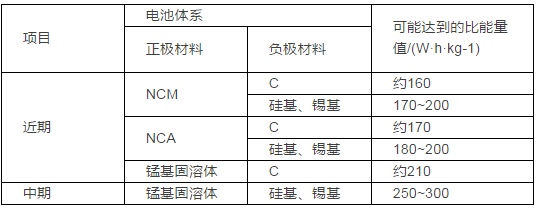
In the future development, the following four directions are worth exploring: higher-capacity ternary materials, higher-power ternary materials, improvement of synthesis methods, and study of ternary materials matching electrolyte additives.
5. Academic progress on ternary materials
Facing the instability of nickel-rich ternary materials, from the University of Texas at Dallas
Professor Kyeongiae Cho's research team has obtained new research results on this issue. They calculated the first-principles calculation combined with the effective interaction of transition metals and established a new model of chemical bonds, explaining why the nickel-rich NCM is unstable.
The team of Roberto C. Longo and Kyeongjae Cho [6] of the University of Texas at Dallas [6] studied the capacity of NCM materials using Li-Ni−Co−Mn quaternary phase diagrams and clarified the order of transition metal structures and positive Effect of electrochemical properties of the material LiNi1−y−xCoyMnxO2 composites. Their experiments show that controlling the atom-scale arrangement of transition metals can increase the mobility of ions and electrons, thereby maximizing the rate performance and cycling stability during cycling.
In the pursuit of high-capacity cathode materials, but also take into account the high-voltage battery electrolyte matching problem, Argonne National Laboratory [7] studied the nickel-rich LiNi0.5Co0.2Mn0.3O2 (NCM523) cathode material The effects of triethylphosphite (TEP) and tris (2,2,2-trifluoroethyl) phosphite (TTFP) as electrolyte additives were obtained and the electrochemical behavior of the battery when the electrolyte contained 1 wt% of TTFP Performance is improved.
6. Dynamics of the lithium battery industry on ternary materials
The policy of cold weather
Tesla from the United States launched the electric car to take the lead in the world, and the Panasonic NCR 18650 3100mAh battery safety issue for this electric vehicle was controversial. The investigation result of a Tesla accident death in Indiana in November last year announced that, according to the American media, the American Indianapolis police announced that the main cause of the accident was a vehicle accident after the accident. In January last year, our Ministry of Industry and Information Technology also said that the suspension of three yuan lithium battery passenger cars into the new energy catalog. The prospects for the development of ternary materials seem to be severe, but this does not stop its development momentum.
Ling Han's ternary material
Hu Linlin, an analyst at the Institute for Lithoflonium Institute for Advanced Industrial Production and Research (GGII), said that subsidies will gradually decline with the increase in battery power. When most companies choose 30 Kwh electricity and high subsidies, they still have to meet the requirements of the customer's long mileage. The company uses triple batteries.
Big investment by giant companies
In an interview with Liemme, the lithium battery company, the company will also accelerate the pace of research, development, and production of ternary materials and seize the high ground. In terms of national policies and raw material prices, ternary materials will be favored in the new round of earnings. The New Energy Vehicle New Deal promulgated at the end of 2016 clearly links the subsidy amount with the battery energy density, and the higher the energy density, the higher the subsidy. The ternary battery theory has a higher energy density, and many lithium giant companies, such as BYD, Ningde, Guoxuan Hi-Tech, and Zhonghang Lithium, will switch to Sanyuan Lithium.
A person in charge of the Ningde era revealed to the media that at present, the company's lithium iron phosphate and ternary capacity accounted for about 2:1, and it will tend to be 1:1 in the next two years. In January of this year, the Ningde era launched the “Development of a New Generation of Lithium-ion Power Battery Industrialization Technology†project in Ningde. The project develops a lithium-ion battery that uses a high-nickel ternary material as the positive electrode and a silicon-carbon composite as the negative electrode. The specific energy of lithium-ion battery is greatly increased from the current 150-180Wh/kg to more than 300Wh/kg, and the cost will be significantly reduced.
BYD's global lithium iron phosphate battery technology leads the world and it is now also deploying ternary lithium batteries on a large scale. According to BYD Secretary General Li Wei, BYD expects to have a battery capacity of 10 GWH in 2016 and a new ternary battery in 2017. -6GWH.
Guoxuan Hi-tech Co., Ltd. has started the industrialization project of producing 10,000 tons of high-nickel ternary cathode materials annually, and the Guosheng Hi-tech Qingdao Company's annual output of 1GWH ternary lithium battery production line has also been put into production.
China Aviation Lithium (Jiangsu) Co., Ltd. plans to start the second phase of the industrial park construction project. The total investment of the project is 437.34 million yuan, and a production line of lithium-ion battery with a capacity of 5 billion watt-hours will be built.
Smart Energy set aside RMB 3.114 billion to increase its plan and expand the production of high-end triple lithium battery production lines. Bump Group invested 1.226 billion yuan to establish a ternary precursor project in June 2016, and is expected to produce 35,000 tons of ternary precursors each year.
- Universal fit: compatible with all automobiles, boats and devices equipped with a 12V power source
- CIRCUIT PROTECTION: Power relay-safety protection and conversion circuit. Blade fuse protects the circuit when overcurrent or short circuit occurs.
- ILLUMINATED SWITCH: 3 pin on/off rocker switch with red indicator light when truing on, easy to turn on or off, has been passed test of 5, 000 times pressing.
- TWO AVAILABLE LEADS: With 2 sets of light output connectors for dual lighting fixtures less than 180W, the connection is more stable.
- PACKAGE INCLUDE:1 x Wiring Harness Kit ,1 x Instructions,
-
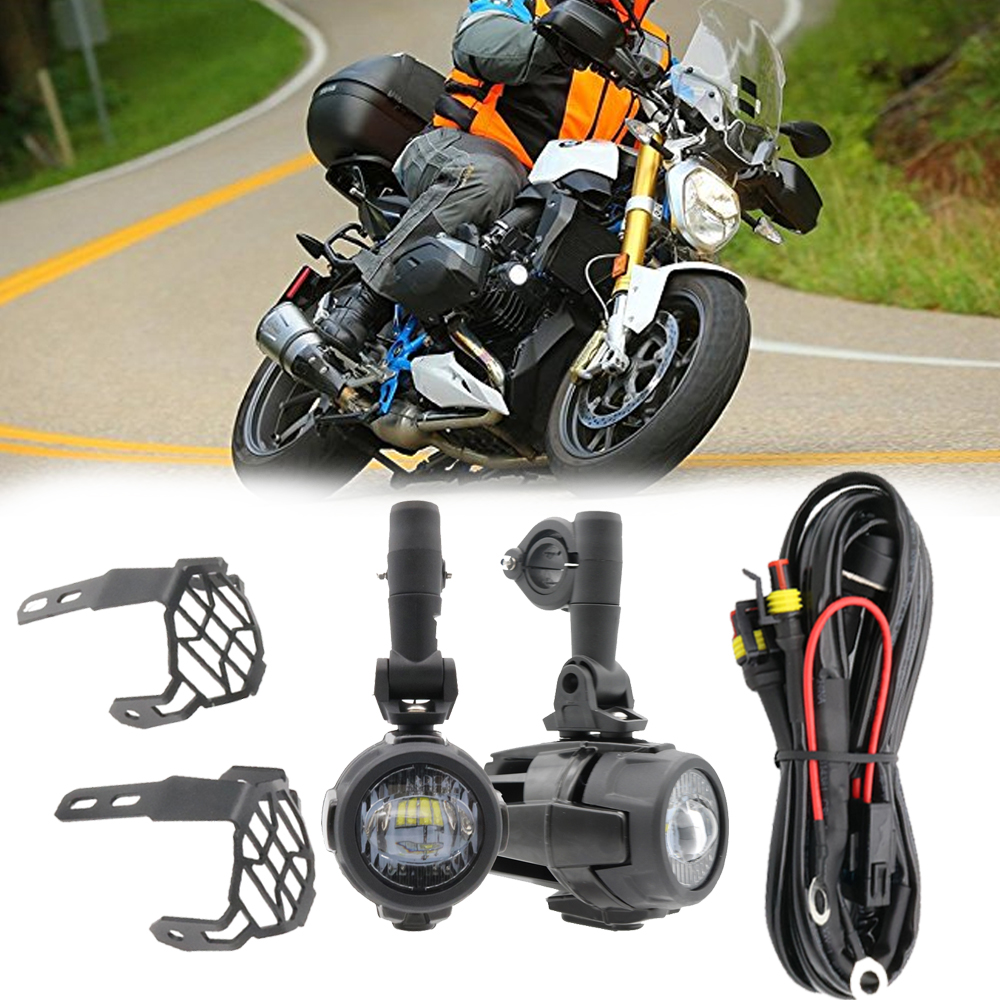
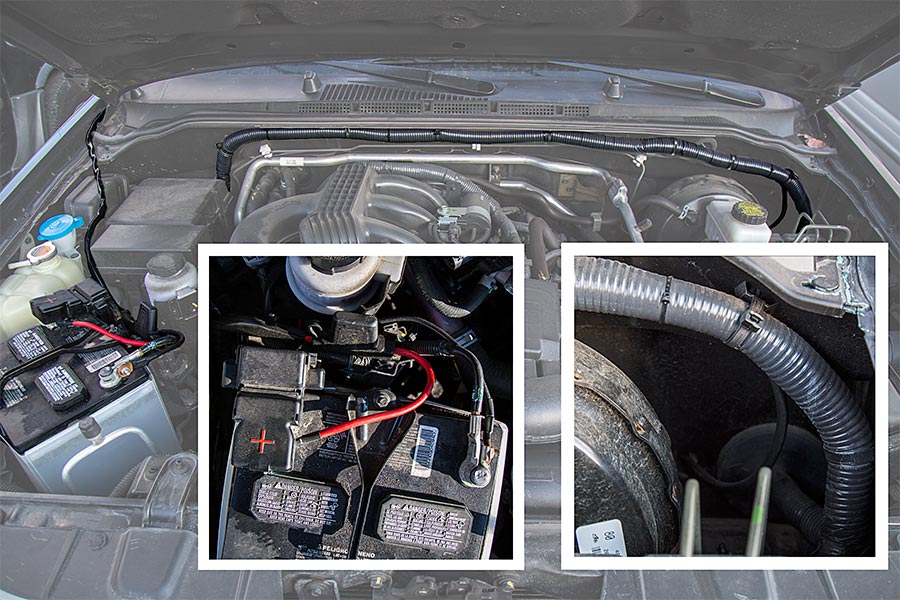
Light Wire Harness,Light Bar Wiring Harness,Led Light Bar Wiring Harness,Led Light Wiring Harness
Dongguan YAC Electric Co,. LTD. , https://www.yacentercns.com